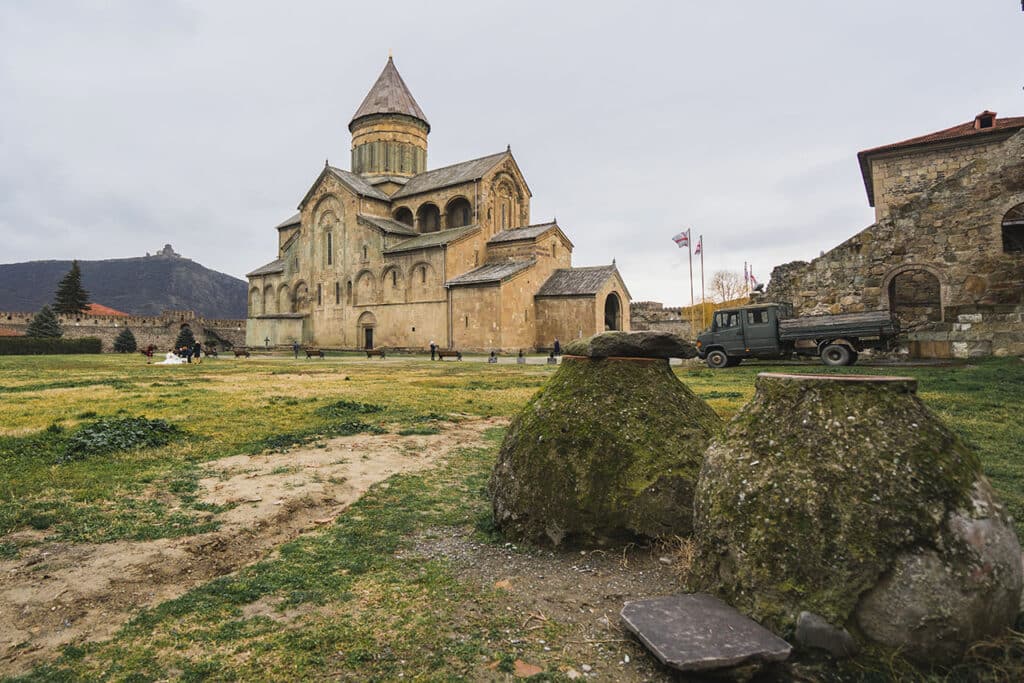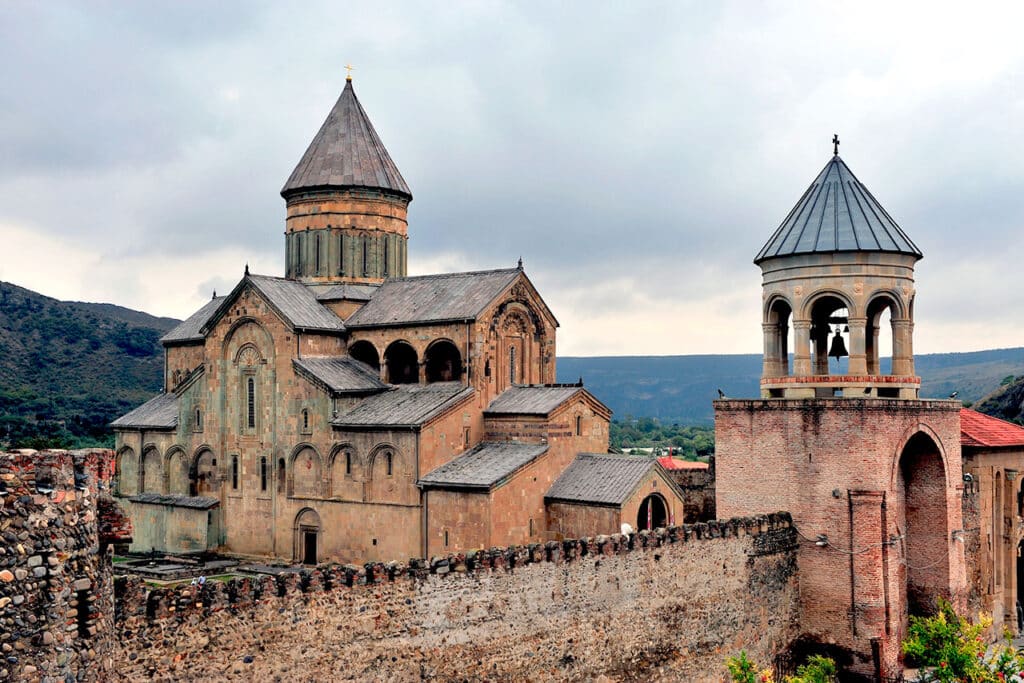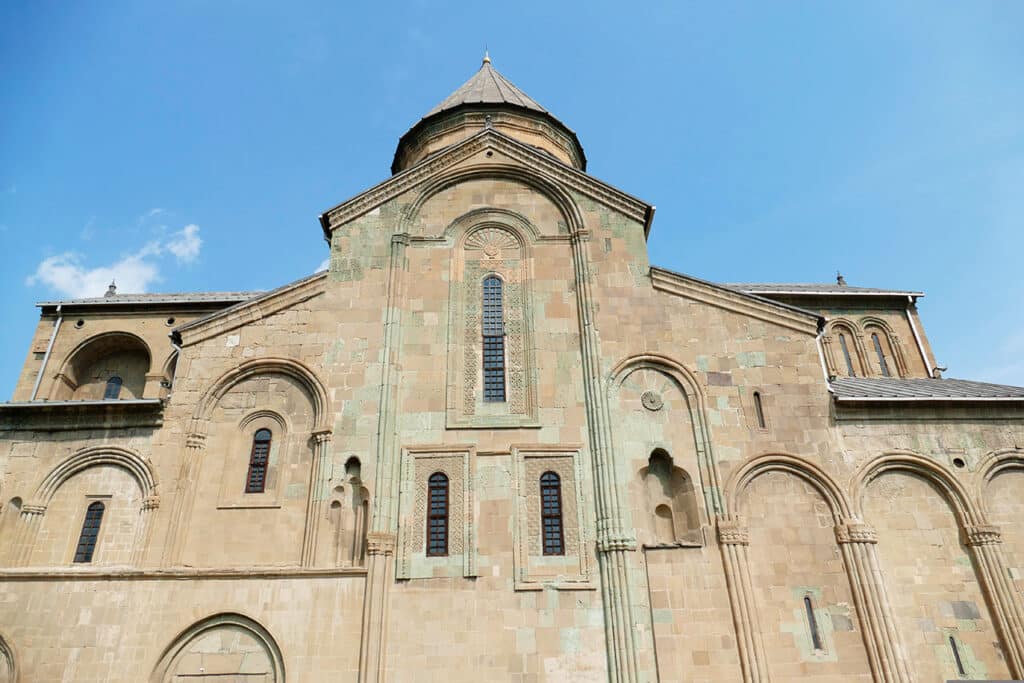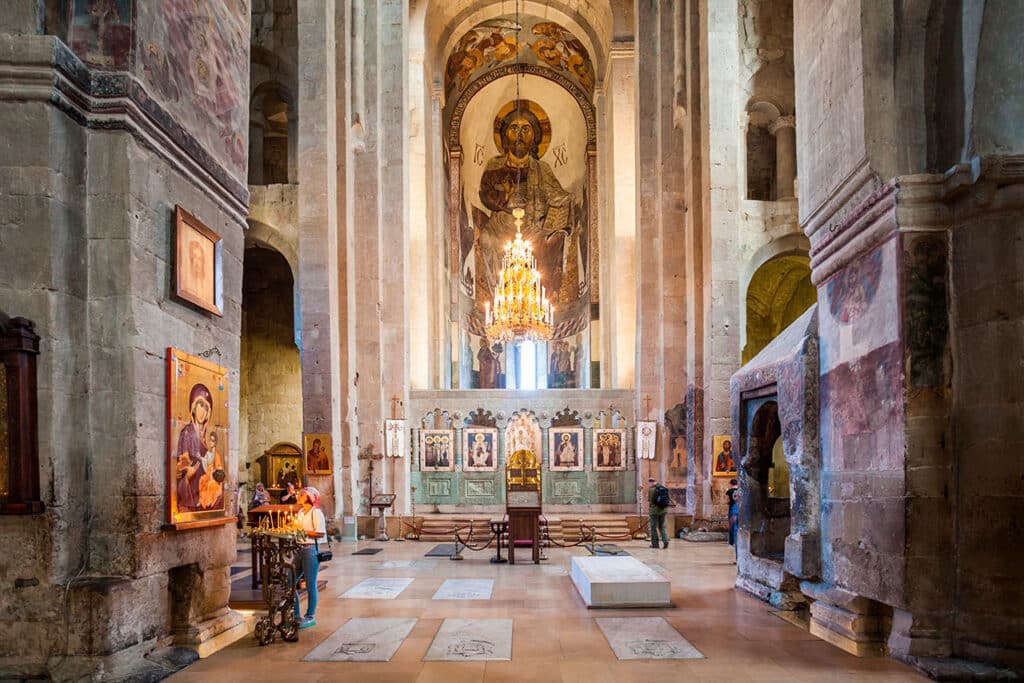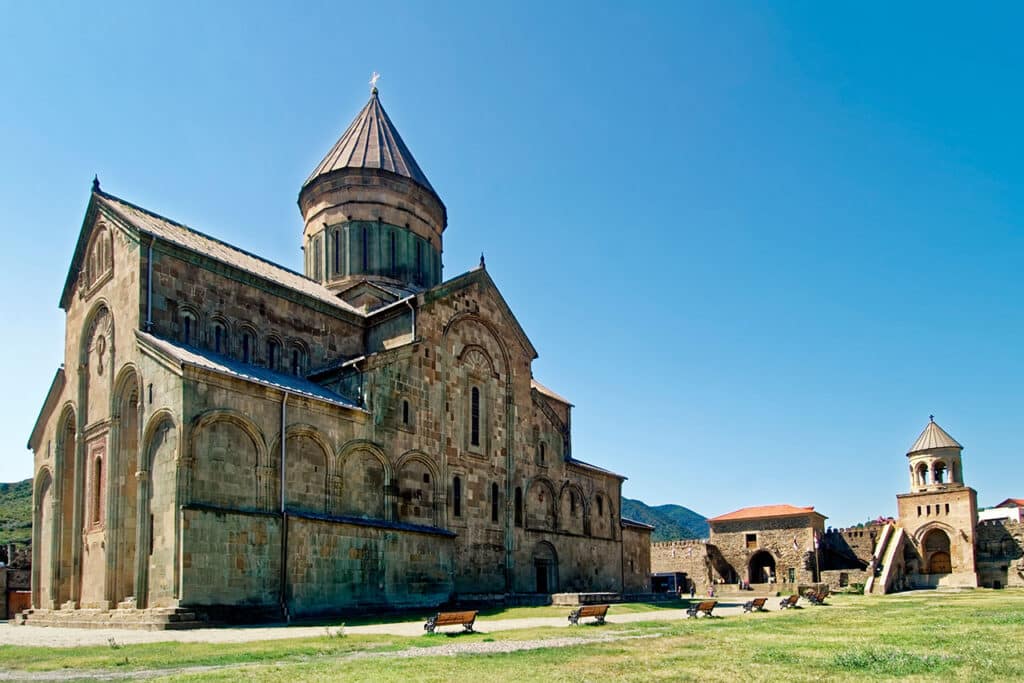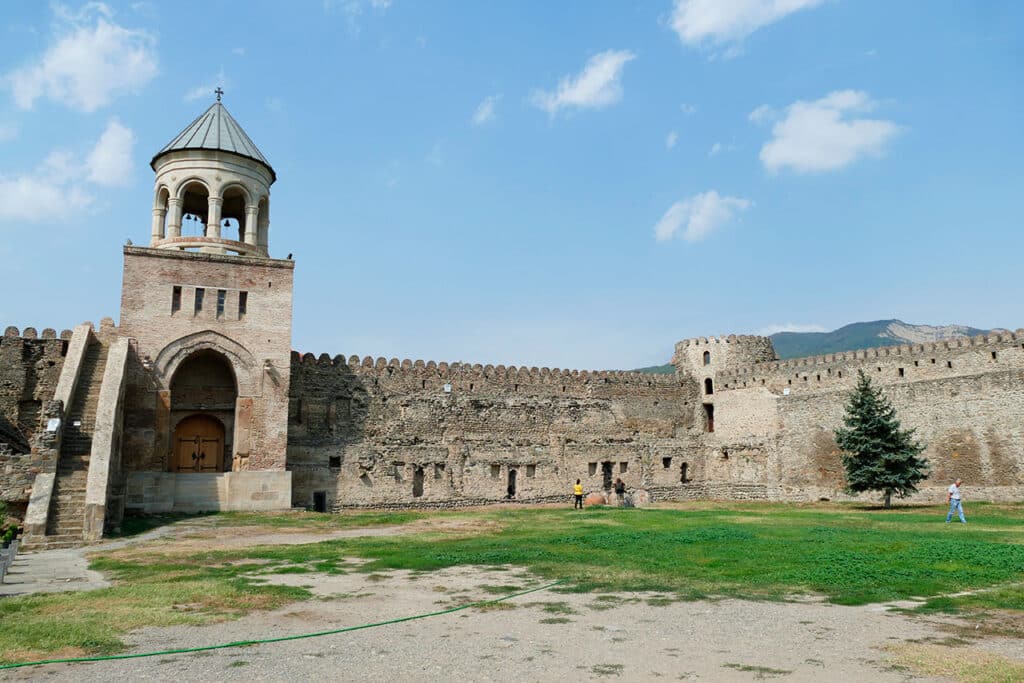Cathedral of Svetitskhoveli near Tbilisi
Just 20 kilometers from Tbilisi, the Cathedral of Svetitskhoveli stands as one of Georgia’s most renowned churches. Thousands of people come to gaze upon it, seeking to connect with the ancient history of this sacred place.
In this article, you will learn about the cathedral’s origin and history, the legend associated with its construction, as well as the unique features and records of the greatest temple in the entire country.
Legend of the Chiton of Jesus Christ
The location for building Svetitskhoveli was not chosen by chance; it is linked to the legend of the chiton that belonged to Jesus. According to the tale, a Jew named Elioz arrived in Jerusalem at the time of the crucifixion of Jesus Christ. Somehow, he managed to obtain the chiton in which the Son of God was executed.
As Elioz was originally from Mtskheta, he took it back to his city and handed it to his sister, Sidonia, who was aware of Jesus’ divine origin. The moment the girl touched the chiton, she died instantly, and her soul ascended to heaven. Thus, she dedicated herself to God and attained the status of a saint. Sidonia was buried in Mtskheta, wrapped in that very chiton.
A cedar tree grew on her grave, which started exuding myrrh. Locals attributed healing properties to it, calling it life-giving. There were stories of witnessing sick animals rapidly recovering after eating the branches’ needles.
History of the Svetitskhoveli Cathedral
In the 4th century AD, Saint Nino, the preacher of Christianity in Georgian lands, arrived in Mtskheta. She gained great recognition from the locals, and even the royal family agreed to switch from paganism to the new faith.
The ruling king at that time, King Mirian, inspired by Nino’s speeches, wanted to build a church. The girl insisted on erecting it precisely on the burial site of Saint Sidonia and the chiton of Jesus. The life-giving cedar was still growing in the royal garden, so it had to be cut down to clear the space for construction.
They made the main pillar of the church from the wood, but they couldn’t install it themselves. According to tales, miraculously, it stood upright by itself, even hovering in the air for a while, resembling a rootless tree. Since the wooden pillar was once that sacred cedar, it retained its properties. It exuded myrrh, healing people and assisting them in life’s challenges by just touching it. The cathedral was named Svetitskhoveli, meaning “Life-Giving Pillar.”
Basilica and the Modern Cathedral
The Church of Svetitskhoveli stood briefly; conquerors destroyed it after 100 years. Remnants of the original church can still be seen today, under glass inside the structure.
Later, the reigning king, Vakhtang Gorgasali (440–502 AD), built a basilica dedicated to the 12 apostles on the ruins of the destroyed Svetitskhoveli (a basilica is a grand structure of elongated form with 2 rows of columns, often serving as a church). The remnants of the basilica include bull heads carved from stone, noticeable on the walls of the modern church.
In the 11th century, during the period of 1010-1029, the grand construction of the Svetitskhoveli Cathedral took place, and it has survived in its present form to this day. The architect of the new cathedral was Arsakidze, and he finished it by engraving his handprint on the church’s facade. Ironically, this same hand was later cut off, a fate common for architects of ancient times, supposedly done to prevent them from repeating or surpassing their creation. People say this was done to ensure they couldn’t create anything as magnificent again.
Outstanding Features of Svetitskhoveli
- The Church of Svetitskhoveli is the first church (4th century) built on Georgian soil, initiated by Saint Nino.
- In 1994, the church was included in UNESCO’s World Heritage List.
- The modern Svetitskhoveli (completed in 1029) preserves elements of the original 4th-century church and Vakhtang Gorgasali’s basilica.
Architecture and Contemporary Appearance
Svetitskhoveli is a traditional cross-dome cathedral. However, it is unusual and even peculiar: the western side of the facade differs significantly from the southern side, and inside, the columns are of various shapes and sizes—no symmetry whatsoever. This might be due to the church being reconstructed many times, and architects aimed to preserve at least a part of the previous building. Remarkable ornaments are carved into the stone walls, differing on each side.
On the doors of the central, western entrance, there is a fresco depicting angels setting up a column from the Life-Giving Cedar (the legend of which is described in the “History of the Svetitskhoveli Cathedral” section). I highly recommend examining other wall frescoes; they are all beautifully and skillfully painted. Some of them interpret biblical stories quite strangely and unusually, adding another mystery to Svetitskhoveli.
Inside the cathedral, it’s worth taking a look at the baptismal font where King Mirian, the Georgian ruler who first embraced Christianity, was baptized.
Although the iconostasis (altar screen) is designed in the style of the 11th century, it is not authentic; it was installed in modern times. All that remains authentic in it is fragments of stone carving. The original screen was dismantled during the Soviet era.
From the very beginning of its construction, Svetitskhoveli served as the burial place for kings and significant Georgian figures. Most of them did not survive, but the graves of Vakhtang Gorgasali, Irakli II, George XII, Princess Tekla, and a few others remain. Tombstones can be seen in the half of the Svetitskhoveli church.
Mtskheta-Svetitskhovloba in Georgia
As Georgia is a religious country, numerous Christian holidays are celebrated. However, one of them is unique—called Mtskheta-Svetitskhovloba, and it is only observed in the city of Mtskheta.
The celebration is dedicated to Georgia’s acquisition of the chiton of Jesus Christ and its subsequent burial in Mtskheta. On its site, the Svetitskhoveli Cathedral was erected following the advice of Saint Nino.
Annually, on October 14th, hundreds of believers gather in Mtskheta from all corners of Georgia. After the festive liturgy, Patriarch Ilia II begins baptizing infants. Many parents aspire to have their babies baptized by the head patriarch, as it is considered very prestigious.
Rules for Visiting
Entering the cathedral should strictly be in modest clothing, no shorts. Women are advised to wear long dresses or skirts, and it’s essential to cover the head with a scarf (a basket of scarves is available at the entrance, but it’s better to have your own).
How to Get to Svetitskhoveli, Mtskheta
From personal experience: Near the cathedral, there are many souvenir shops (by the way, here is an article with tips on what and where to buy souvenirs). Whenever I find myself in Mtskheta, I always buy local churchkhela. It is very tender and delicious here. Mtskheta churchkhela is a unique dessert not resembling those made in other regions. I get 10-15 pieces for myself and the same for my close ones. Highly recommended!
- Train: Trains from the central railway station in Tbilisi to Borjomi, Uzurgeti, and Kutaisi stop near Mtskheta. Schedules and prices change, and you can check on the official website of Georgian Railways: railway.ge. The journey takes about 30 minutes, but the train reaches a station 3 kilometers from Mtskheta. You’ll have to take a taxi or walk to the final destination, making it not very convenient.
- Minibus from Didube Station: A fast and inexpensive way. They run from 8 am to 8 pm every half hour, reaching Mtskheta in about 40 minutes. The trip costs 5-10 lari.
- Taxi: The most comfortable option. From Freedom Square directly to Svetitskhoveli, you will be taken for 22-28 lari (depending on traffic) and 40 minutes.
- Tours: The best option. An opportunity to see not only Svetitskhoveli but also Jvari and Samtavro. There are budget group options lasting 3-4 hours. There are also individual ones. Plenty of choices. Select based on price and reviews.
More about Georgia:

Hello!
I am Victor, the founder of this site and its main, but not the only author.
Traveler and photographer. Visited more than 40 countries.
Born and raised in Batumi. I love to travel in Georgia.
More about me here.



